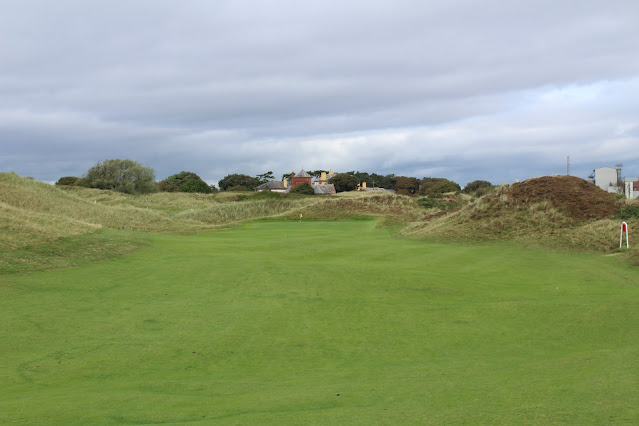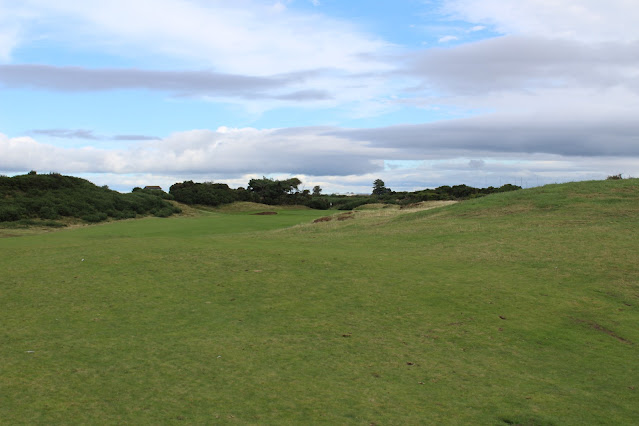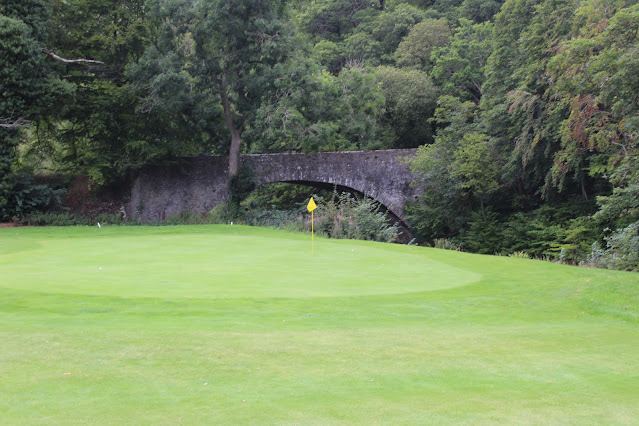Sunday, March 05, 2023
Dumbarnie Links
Sunday, February 05, 2023
Silloth-on-Solway - England's Cruden Bay
The clubhouse at Silloth with the Union Jack at half mast to mark the Queen's passing
America has some phonetic place names that roll off the tongue in a lyrical manner: Tucumcari, Sheboygan, Walla Walla, Valparaiso, Kokomo, and Ronkonkoma come to mind. They not only mark a location on the map, but conjure up images in the wandering mind of far off places that an itinerant traveler would love to see one day (although from personal experience I can tell you there is no need to visit Ronkonkoma). Many were taken from Native American names and are rhapsodic.
While America has some amusing locales, the mother ship remains England. After all, a land that produced Shakespeare, Milton, and Chaucer has a birthright in the field of toponymy. The upstart colony can’t compete with a country that has towns named Newcastle-upon-Tyne, Virginia Water, Barrow-in-Furness, Preston-under-Scar, Berwick-upon-Tweed, Goring-by-Sea, Wells-next-the-Sea, and Branksome Chine. Many of these towns take their name from a mixture of Old English and Old Norse, and in my view they can’t be beat.
Okay, enough of the diversion, back to the topic at hand, which is golf, and specifically a new find called Silloth-on-Solway. What? Another one of those barmy place names. Silloth means roughly “sea barn,” and Solway is the body of water the town is located on, as in Solway Firth, part of the Irish Sea. The golf course is located directly on the Firth with clear views across the water to Scotland, with the rounded peaks of the Galloway Hills in the Southern Highlands only eight miles away. The area has been designed by the government as an Area of Outstanding Natural Beauty.
Sandwiched above the Lake District of England, with its sweeping views of the Cumbrian Mountains, and below the Scottish Borders region, Silloth is not a course you happen upon by chance. Located almost three hours from Prestwick to the north or two and a half from Royal Birkdale to the south, this is destination golf. Silloth had its heyday during the Victorian Era, when it was a beach holiday town.
Even when you are intent on finding Silloth-on-Solway, it is a challenge, as the course is hidden behind the town. The GPS system on our car couldn't find Silloth and left us on a dirt path near the outskirts of the course. You have to take a circuitous route to finally get to the clubhouse, which is located behind an industrial park.
I have yet to find a Willie Park, Jr. designed golf course I didn’t like. I went out of my way to play at Silloth because I love Park’s designs at Sunningdale and Maidstone. It was also recommended by three golf aficionados whose opinions I trust, beginning with Ran Morrissett who wrote an enticing profile on Golf Club Atlas, albeit it accompanied by some dated pictures. Another motivator was the fact that Darius Oliver included the course as one of the top 100 courses outside the United States in his Planet Golf book, where we writes glowingly about the course, “Silloth is less conventional and full of hidden greens, blind driving zones, large central hills that obscure targets on par fives and small plateau greens on long, downwind par threes . . . golf at its most raw and the game is poorer for the fact that courses like this are no longer being built.” Finally, my friend Fergal O’Leary, implores rabid golfers to visit, “PLEASE GO TO SILLOTH! You’ll be immensely rewarded! I will forever vote this course comfortably within the Top 100 courses in the World.”
I took Fergal’s advice and went to Silloth and was indeed rewarded. It has one of the best opening stretches of any golf course in the world.
You know Silloth is going to be different right from the get go. The picture above shows the first fairway with its natural undulations among the dunes. The approach on the first green is blind with a long pole sticking up so you have an aiming point.
The third hole is a dogleg left with a wildly undulating fairway--you won't find many flat lies on the course--set between two lines of dunes. The image above was taken from the top of an observation ladder you climb to see if the coast is clear, because it is yet again another blind shot. You can start to get a sense of why I called Silloth England's Cruden Bay, because of its abundance of blind shots and because of its routing among the dunes. The unconventional course is rough and tumble with a sense of spirit that is rare to find in golf.
There is another aiming pole off the tee for the blind approach to the 4th green. It is at this point that you either fall in love with the golf course or hate it. I like blind shots since they introduce an element of surprise, but some people hate them. Two of my playing companion friends hated it and it felt like there were too many blind shots, particularly because there is so much gorse to contend with. They aren't opposed to blind shots per se, but it is the combination of the abundance of blind shots with the penal nature of the gorse that they thought was unfair. In my mind you have to put yourself back in time. After all, the course was built in 1892 when blind shots were common. If you want to play the most recent Tom Fazio course without blind shots, go ahead, Silloth probably isn't for you. While many of the world's best courses have blind shots including Royal County Down, Royal Portrush, Prestwick, Lahinch, National Golf Links, and New South Wales, the combination of an abundance of blind shots with the gorse does make Silloth particularly challenging. It didn't bother me, in fact, I found the unconventional nature of it exhilarating.
In addition to a blind tee shot on the 4th, the unsuspecting golfer has no clue as to what is to come on this bunkerless hole. Hit the green and there are no worries. Miss the green and you will face a challenge unlike almost any other in the world of golf.
The par-5 fifth hole is the first one on the course that doesn't feature a blind shot. In addition to blind shots and gorse hazards, the course also features strategically placed pot bunkers as seen here on the fifth, which hugs the beach from tee to green.
The drive off the 11th hole features . . . drum roll please . . . you guessed it, a blind shot! Unless the tee shot is positioned to the left it blocks the golfer out from the green.
The club calls the 13th hole, nicknamed Hog's Back, its signature, but I thought it was one of the poorest designs on the course. A par-5 of 509 yards, the drive is a forced carry over heather and gorse and for someone who hadn't played the course before I wasn't sure whether the fairway was to the left or the right on the second shot. It's to the left, and the third shot plays to a goofy elevated table top green that is inconsistent with the rest of the greens on the course.
The back nine features three par fives, including two back to back. The back nine is inevitable a letdown after the excitement of the start. The front nine has five holes with blind shots (1st, 2nd, 3rd, 4th, and 7th) and the back only has one (11th), in addition the back has less gorse and less severe dunes. It also plays more inland and further away from the Firth. The finishing hole at Silloth is a card wrecking par 4 that we played into the wind, making it a real tester.
Although I mentioned that the course is a design of Willie Park, Jr., as is frequently cited, it was actually laid out by Davie Grant with an assist by Mungo Park, Willie's uncle and the winner of the Claret Jug in 1874. Park, Jr. made his changes around the turn of the 20th century and Alister Mackenzie consulted for the club just prior to the First World War, but due to financial difficulties the only imprint from the Good Doctor is today's third green and fourth tee. The club's history gives the majority of the credit to Grant, "the major influences in the design of the Silloth course have been Davie Grant, in his original layout, and the Greens Committees of the 1900s. The more celebrated Willie Park Jr., Willie Fernie and Alister Mackenzie appear to have been supporting players."
It is interesting to fantasize about composite courses, a compilation of the best holes you have played made into one fantasy course. Well, Silloth-on-Solday has many of the holes all here in one place. The 5th hole resembles the 9th at Maidstone; the blind par three Dell hole at Lahinch is replicated often on approach shots; the 6th hole, with its sea of gorse off the tee like County Down’s 4th hole; the 7th is reminiscent of the first at St. Enodoc; the 13th is like the 10th at Maidstone; and the 14th has the rippling fairway reminiscent of the 8th at Prairie Dunes. Ran Morrissett describes the 4th as similar to the opening hole at Pine Valley as well.
I’m in total agreement with my friend Fergal's thoughts about Silloth, “I’d like to end this with a very strong opinion I personally hold as follows. I get so frustrated when people say 'if X course was located closer to Y city/region, then it would be rated so much higher.' This lazy attitude is insulting to the course and the club should never suffer in the rankings just because of its location. If the course is worthy of merit and is architecturally superior to a list of overrated courses, then give credit when credit is due! Making the extra effort to find the best courses on earth is the exciting part! We frequently rank courses in Tasmania that are essentially at the end of the earth, so don’t tell me the northwest of England is too far out of the way.” Of course, he is 100% right. Courses in Ayrshire like Troon, Prestwick and Turnberry are naturally clustered together for a golf trip as are the courses around St. Andrews, thus they get a lot of notoriety. Silloth stands alone in the far north of England, therefore it doesn't get the accolades it deserves.
The course suffers from what I call a lack of “Instagram” appeal. Magazines and websites tout the newest cool thing, which you can’t fault them for since it supports their business model and advertisers. Some clubs, especially new ones, go out of their way to court raters, bending over backwards to accommodate them. Silloth suffers from opening in 1892, and not 2022, thus there is no fanfare about it and no sexy marketing campaign to engage in.
Bernard Darwin wrote in A Round of Golf: “I never more violently fell in love with a course at first sight. There never was a prettier or more truly golfing beginning to any course than there is at Silloth, a tee shot down a shallow valley, with sand a hillocks and heather on either side—a little reminiscent of some of the shots at Formby or Birkdale. Fascinating greens that go dodging about amid delicious country.”
We should treat old historic courses like this with more respect, and a three hour drive among delightful country is hardly an imposition. Silloth has heart and soul and a unique character and is worth the journey!














.jpg)































